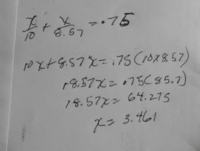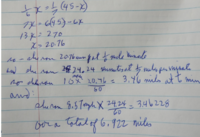allegansveritatem
Full Member
- Joined
- Jan 10, 2018
- Messages
- 962
Here is the problem:
62. Jogging rates: A woman begins jogging at 3:00pm, running due north at a 6-minute-mile pace. Later, she reverses direction and runs due south at a 7-minute-mile pace. If she returns to her starting point at 3:45pm, find the total number of miles run.
Here is what I did with it:

This can't be right but it is all I could come up with. The 10 and 8.57 are the hourly rates. the .75 is the time in hours. I think the true solution here would yield something between 6.5 and 7 miles.
62. Jogging rates: A woman begins jogging at 3:00pm, running due north at a 6-minute-mile pace. Later, she reverses direction and runs due south at a 7-minute-mile pace. If she returns to her starting point at 3:45pm, find the total number of miles run.
Here is what I did with it:

This can't be right but it is all I could come up with. The 10 and 8.57 are the hourly rates. the .75 is the time in hours. I think the true solution here would yield something between 6.5 and 7 miles.
Attachments
Last edited by a moderator:


